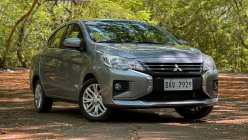In this article...
- Mitsubishi Mirage G4 GLS 2013: Other Parts
- 3. Mitsubishi Mirage G4 GLS 2013: Controls
- 4. Mitsubishi Mirage G4 GLS 2013: Engine & Performance
Mitsubishi Mirage G4 GLS 2013: Other Parts
The leather-wrapped steering wheel has the right heft which makes it easy to grip, and features two-way tilt adjustment. One of the steering wheel’s panels has a remote button for the audio system’s volume, mode and track selection, which I found rather redundant since the head unit is within easy reach.

Leather steering wheel with audio controls. The silver finish on the panels tends to wear off with extended use.
Worse, the remote is powered by a CR2354 dry cell battery instead of being connected directly to the car’s power supply, which means the panel has to be removed to access the battery once it runs out and needs replacement. It’s an inconvenient affair to say the least, which runs the risk of loosening the panel over time.
The Mirage G4 has an engine start/stop button, again similar to more upscale (and expensive) models, although it happens to be located to the left of the steering column, presumably to prevent curious passengers from pressing it and accidentally turning off the engine in the middle of a drive.
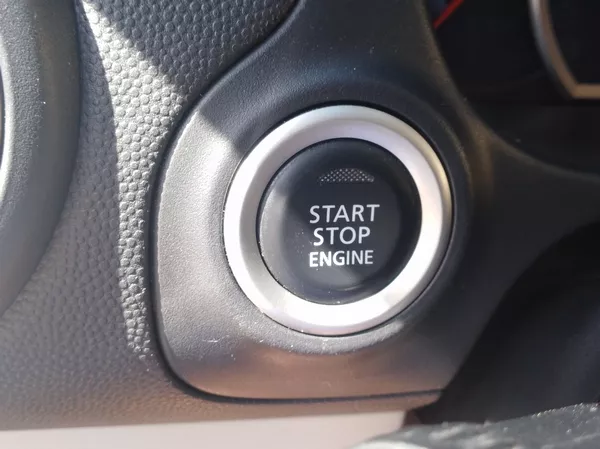
Engine push start button of the Mirage G4
A 7-inch touchscreen head unit comes standard on the Mitsubishi Mirage G4 GLS 2013, with Bluetooth handsfree functionality for when you need to take calls while driving. The system also features onboard GPS (no real-time traffic data though), with maps saved on a microSD card that goes into a slot on the right side of the display.
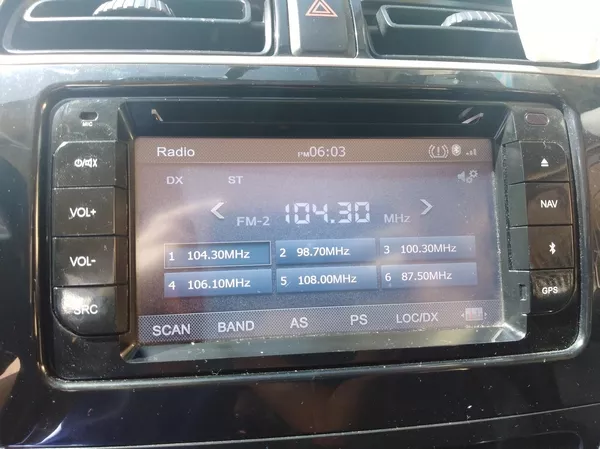
The in-dash touch screen
For entertainment, the unit has an AM/FM radio tuner, CD/DVD slot, and iPod connectivity via USB slot or AUX port, with output played back through four speakers. The interface can be occasionally sluggish, especially when selecting songs on my iPod Classic, and the tracks inexplicably alternate between stereo and mono when the GPS is enabled.
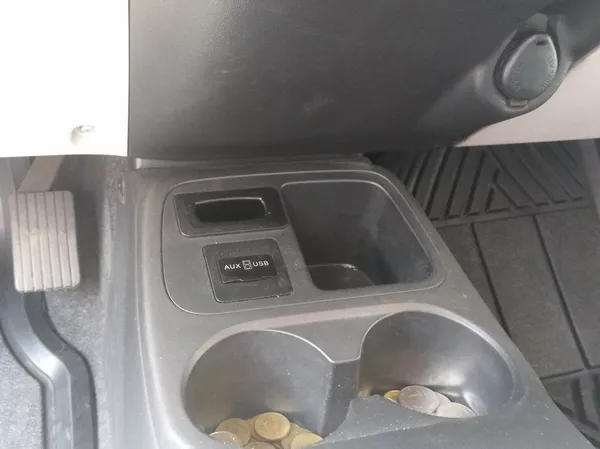
Front console with FAST key slot, USB port and AUX input. The two cupholders can double as coin bins.
Additionally, there’s a menu function which enables the driver to monitor the car’s tire pressure in real time, but this works only if you purchase the optional tire pressure sensors.
Another interior feature on the Mitsubishi Mirage G4 2013 is automatic climate control, utilizing electronic buttons instead of knobs and dials. Cooling power is adequate, especially on summer drives, although I find myself wishing that it still had second-row vents for the passengers. The side vents open and close using three overlapping panels which I found a bit flimsy, especially if you try mounting a smartphone on them. Meanwhile, the central vents can only be tilted up, down and sideways, but never closed.

The G4's climate control. Note that the AUTO mode adjusts fan speed only, not the thermostat.
The Mirage G4’s instrument panel uses a large analog speedometer at the center and an analog tachometer on the left side. The right side houses indicator lights such as those for ECO Assist, door ajar, engine temperature, airbag, check engine and so on. While it simplifies the information fed to the driver, the indicator lights can be confusing at times; for instance, a red engine temperature lamp only warns you that your engine is about to overheat, but doesn’t say by how much, which can be quite panic-inducing.
The multi-information display below the speedometer displays average fuel consumption as well as odometer, trip meter, remaining fuel and approximate range readings. I noticed that driving upwards on inclines adds to the display segments showing the remaining fuel supply, meaning that the fuel sensor is likely located at the rear of the fuel tank. Users can switch between miles and kilometers for unit measurement.
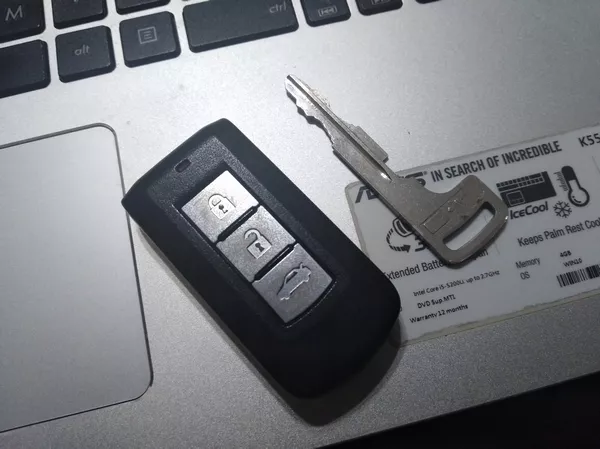
FAST key remote with buttons to lock and unlock the alarm, as well as opening the trunk remotely. Emergency key at the right
Both GLS variants of the hatchback and the sedan come with a FAST key module, basically a low-power radio transmitter that lets you start the car as long as the key is inside, without having to place it on the key slot. It has dedicated buttons to remotely lock and unlock the doors, plus a third button that opens the trunk even from a distance, which is a neat parlor trick to show off to friends and strangers alike.
Both the hatchback and sedan are known for having feather-light pedals; so light in fact, that the first time I drove the car away from the dealership, I stalled six times on the road. The manual variant has quite the unforgiving clutch, so you need to find that sweet spot between overrevving and stalling the engine every time you engage the gears. The gearshift lever could have had shorter throws, but in any case, the Mirage G4 isn’t exactly advertised as a sport model.
>>> Read more: Mirage G4 vs Vios: Who takes the honor in B-segment sedan
3. Mitsubishi Mirage G4 GLS 2013: Controls
The leather-wrapped steering wheel has the right heft which makes it easy to grip, and features two-way tilt adjustment. One of the steering wheel’s panels has a remote button for the audio system’s volume, mode and track selection, which I found rather redundant since the head unit is within easy reach.

Leather steering wheel with audio controls. The silver finish on the panels tends to wear off with extended use.
Worse, the remote is powered by a CR2354 dry cell battery instead of being connected directly to the car’s power supply, which means the panel has to be removed to access the battery once it runs out and needs replacement. It’s an inconvenient affair to say the least, which runs the risk of loosening the panel over time.
The Mirage G4 has an engine start/stop button, again similar to more upscale (and expensive) models, although it happens to be located to the left of the steering column, presumably to prevent curious passengers from pressing it and accidentally turning off the engine in the middle of a drive.

Engine push start button of the Mirage G4
A 7-inch touchscreen head unit comes standard on the Mitsubishi Mirage G4 GLS 2013, with Bluetooth handsfree functionality for when you need to take calls while driving. The system also features onboard GPS (no real-time traffic data though), with maps saved on a microSD card that goes into a slot on the right side of the display.

The in-dash touch screen
For entertainment, the unit has an AM/FM radio tuner, CD/DVD slot, and iPod connectivity via USB slot or AUX port, with output played back through four speakers. The interface can be occasionally sluggish, especially when selecting songs on my iPod Classic, and the tracks inexplicably alternate between stereo and mono when the GPS is enabled.

Front console with FAST key slot, USB port and AUX input. The two cupholders can double as coin bins.
Additionally, there’s a menu function which enables the driver to monitor the car’s tire pressure in real time, but this works only if you purchase the optional tire pressure sensors.
Another interior feature on the Mitsubishi Mirage G4 2013 is automatic climate control, utilizing electronic buttons instead of knobs and dials. Cooling power is adequate, especially on summer drives, although I find myself wishing that it still had second-row vents for the passengers. The side vents open and close using three overlapping panels which I found a bit flimsy, especially if you try mounting a smartphone on them. Meanwhile, the central vents can only be tilted up, down and sideways, but never closed.

The G4's climate control. Note that the AUTO mode adjusts fan speed only, not the thermostat.
The Mirage G4’s instrument panel uses a large analog speedometer at the center and an analog tachometer on the left side. The right side houses indicator lights such as those for ECO Assist, door ajar, engine temperature, airbag, check engine and so on. While it simplifies the information fed to the driver, the indicator lights can be confusing at times; for instance, a red engine temperature lamp only warns you that your engine is about to overheat, but doesn’t say by how much, which can be quite panic-inducing.
The multi-information display below the speedometer displays average fuel consumption as well as odometer, trip meter, remaining fuel and approximate range readings. I noticed that driving upwards on inclines adds to the display segments showing the remaining fuel supply, meaning that the fuel sensor is likely located at the rear of the fuel tank. Users can switch between miles and kilometers for unit measurement.

FAST key remote with buttons to lock and unlock the alarm, as well as opening the trunk remotely. Emergency key at the right
Both GLS variants of the hatchback and the sedan come with a FAST key module, basically a low-power radio transmitter that lets you start the car as long as the key is inside, without having to place it on the key slot. It has dedicated buttons to remotely lock and unlock the doors, plus a third button that opens the trunk even from a distance, which is a neat parlor trick to show off to friends and strangers alike.
Both the hatchback and sedan are known for having feather-light pedals; so light in fact, that the first time I drove the car away from the dealership, I stalled six times on the road. The manual variant has quite the unforgiving clutch, so you need to find that sweet spot between overrevving and stalling the engine every time you engage the gears. The gearshift lever could have had shorter throws, but in any case, the Mirage G4 isn’t exactly advertised as a sport model.
>>> Read more: Mirage G4 vs Vios: Who takes the honor in B-segment sedan
4. Mitsubishi Mirage G4 GLS 2013: Engine & Performance
The leather-wrapped steering wheel has the right heft which makes it easy to grip, and features two-way tilt adjustment. One of the steering wheel’s panels has a remote button for the audio system’s volume, mode and track selection, which I found rather redundant since the head unit is within easy reach.

Leather steering wheel with audio controls. The silver finish on the panels tends to wear off with extended use.
Worse, the remote is powered by a CR2354 dry cell battery instead of being connected directly to the car’s power supply, which means the panel has to be removed to access the battery once it runs out and needs replacement. It’s an inconvenient affair to say the least, which runs the risk of loosening the panel over time.
The Mirage G4 has an engine start/stop button, again similar to more upscale (and expensive) models, although it happens to be located to the left of the steering column, presumably to prevent curious passengers from pressing it and accidentally turning off the engine in the middle of a drive.

Engine push start button of the Mirage G4
A 7-inch touchscreen head unit comes standard on the Mitsubishi Mirage G4 GLS 2013, with Bluetooth handsfree functionality for when you need to take calls while driving. The system also features onboard GPS (no real-time traffic data though), with maps saved on a microSD card that goes into a slot on the right side of the display.

The in-dash touch screen
For entertainment, the unit has an AM/FM radio tuner, CD/DVD slot, and iPod connectivity via USB slot or AUX port, with output played back through four speakers. The interface can be occasionally sluggish, especially when selecting songs on my iPod Classic, and the tracks inexplicably alternate between stereo and mono when the GPS is enabled.

Front console with FAST key slot, USB port and AUX input. The two cupholders can double as coin bins.
Additionally, there’s a menu function which enables the driver to monitor the car’s tire pressure in real time, but this works only if you purchase the optional tire pressure sensors.
Another interior feature on the Mitsubishi Mirage G4 2013 is automatic climate control, utilizing electronic buttons instead of knobs and dials. Cooling power is adequate, especially on summer drives, although I find myself wishing that it still had second-row vents for the passengers. The side vents open and close using three overlapping panels which I found a bit flimsy, especially if you try mounting a smartphone on them. Meanwhile, the central vents can only be tilted up, down and sideways, but never closed.

The G4's climate control. Note that the AUTO mode adjusts fan speed only, not the thermostat.
The Mirage G4’s instrument panel uses a large analog speedometer at the center and an analog tachometer on the left side. The right side houses indicator lights such as those for ECO Assist, door ajar, engine temperature, airbag, check engine and so on. While it simplifies the information fed to the driver, the indicator lights can be confusing at times; for instance, a red engine temperature lamp only warns you that your engine is about to overheat, but doesn’t say by how much, which can be quite panic-inducing.
The multi-information display below the speedometer displays average fuel consumption as well as odometer, trip meter, remaining fuel and approximate range readings. I noticed that driving upwards on inclines adds to the display segments showing the remaining fuel supply, meaning that the fuel sensor is likely located at the rear of the fuel tank. Users can switch between miles and kilometers for unit measurement.

FAST key remote with buttons to lock and unlock the alarm, as well as opening the trunk remotely. Emergency key at the right
Both GLS variants of the hatchback and the sedan come with a FAST key module, basically a low-power radio transmitter that lets you start the car as long as the key is inside, without having to place it on the key slot. It has dedicated buttons to remotely lock and unlock the doors, plus a third button that opens the trunk even from a distance, which is a neat parlor trick to show off to friends and strangers alike.
Both the hatchback and sedan are known for having feather-light pedals; so light in fact, that the first time I drove the car away from the dealership, I stalled six times on the road. The manual variant has quite the unforgiving clutch, so you need to find that sweet spot between overrevving and stalling the engine every time you engage the gears. The gearshift lever could have had shorter throws, but in any case, the Mirage G4 isn’t exactly advertised as a sport model.
>>> Read more: Mirage G4 vs Vios: Who takes the honor in B-segment sedan
Recent posts
- Latest Mitsubishi Mirage G4 Price Philippines 2025 Dec 31, 2019
- Thailand-spec Mitsubishi Mirage G4 2019 gets great revamps Oct 06, 2020
- Latest Mitsubishi Mirage G4 Price Philippines 2025 Dec 02, 2019
- Mitsubishi Mirage G4: the first car made by Filipino hands Oct 19, 2020






